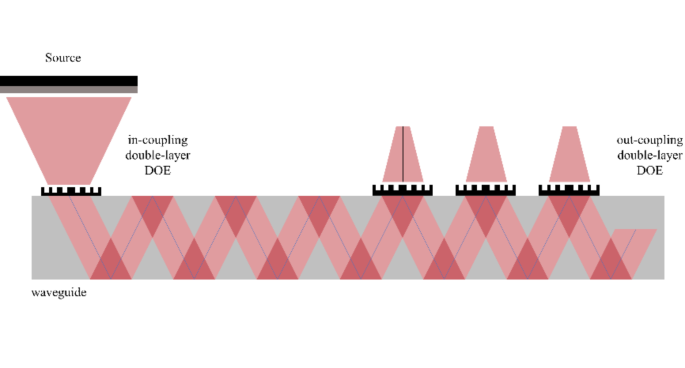Double layer diffractive waveguide
Introducing the Double Layer Diffractive Waveguide: Revolutionizing Imaging Systems
In the world of optics and imaging technology, a groundbreaking innovation has emerged – the double layer diffractive waveguide. This cutting-edge system is designed to enhance the field of view (FOV) collimation and reconstruction process, offering a new level of precision and efficiency in optical imaging.
The double layer coupling waveguide imaging system consists of a cross-section, as depicted in Figure 1. It utilizes two double layer diffractive optical elements for in-coupling and out-coupling, enabling the modification of wavefront phases to achieve collimation and diffraction. The waveguide system is constructed using a lanthanum dense flint glass material, providing a high refractive index for optimal performance.
Figure 2 illustrates the intricate light shaping process involved in the in-coupling and out-coupling of double layer diffractive optical elements. By modeling the surface light source as a two-dimensional point source array, the system ensures accurate and efficient light information transmission.
One of the key limitations addressed by the double layer diffractive waveguide is the field of view (FOV) transition from air to the waveguide, as shown in Figure 3. By modulating optical information into a planar wavefront and utilizing total internal reflection within the waveguide, the system overcomes traditional FOV constraints, achieving a maximum FOV of 90° × 90°.
Pupil duplication is another crucial aspect of the system, allowing for exit pupil extension and increased eyebox size. Through a series of Total Internal Reflections (TIRs) at specific angles, the input entrance pupil is replicated to enhance imaging capabilities, as demonstrated in Figure 4.
The intensity, uniformity, and coefficient of variation of the system are meticulously calculated to ensure optimal performance. By analyzing the efficiency of in-coupling and out-coupling diffractive optical elements, the system achieves high uniformity and energy utilization, as outlined in the equations provided.
In conclusion, the double layer diffractive waveguide represents a significant advancement in imaging technology, offering unparalleled precision, efficiency, and versatility. With its innovative design and sophisticated capabilities, this system is set to revolutionize the way we perceive and interact with optical imaging.
